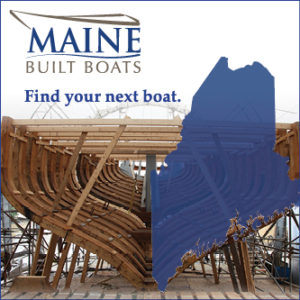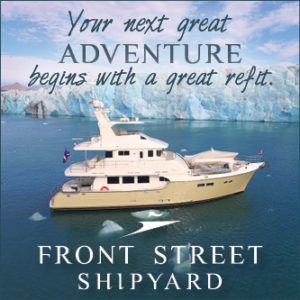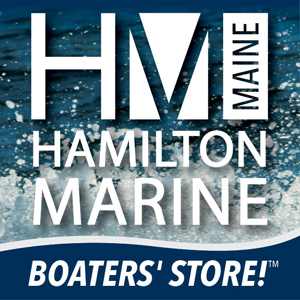PEPPERELL, MA – For years, I had correspondence with Russell Cleary of Pepperell, Massachusetts, asking all sorts of questions about sportfishing boats. I knew from his interest that at some point it would be good to get together, but that did not happen until the end of April. After our discussion about sword and tuna fishing and the boats that they used, I left knowing that I should have got together years ago. I especially wanted to read a copy of the book he just released, “On the Fish, The Harpoon Swordfishing Vessels of the New England Fleet, 1850-1975.” Just thumbing through it, this is an impressive book.
Russell began by saying, “I was born in Boston and grew up in Concord, Massachusetts. What does a Concord guy have to do with the ocean, right? My father came from Gloucester, Massachusetts, Lanesville. Although my family was not heavily involved in fishing, I did have an uncle and a godfather whose brother-in-law was the highline halibut killer out of Gloucester. His vessel was the KATHERINE, which was a Thomas McManus designed schooner. My father’s family was more involved in the granite trade. My grandfather was a stone cutter. He eventually had his own monuments business, but he never made a lot of money. My father graduated from Gloucester High School in 1934 taking a general course of study, not a college preparatory course of study. He was tuna fishing, but as far as steady work, I know he was an ice man for a while. I think that is how he met my mother. In the midst of all of this he got a hankering to be a dentist. He took the train from Gloucester into Tufts and talked with the dean of the dental school. The dean said, ‘If you are interested in the dental school you have got to start as an undergraduate in the four-year college first. However, you are going to have to go back to high school and repeat your senior year.’ So, he went back to high school. My father, since he lived in this fishing village, Lane’s Cove, he tuna fished as a teenager. He fished with Dr. Frederick Brooks Breed. He developed the electric harpoon for tuna and swordfish, although they didn’t have it calibrated properly for swordfish at the time. It would jelly the fish, and it would ruin the flesh, sometimes all of it, sometimes just a section along the backbone. It worked great for tuna. Dr. Breed later owned the JAGUAR, which was first a 38-foot tuna boat and then a 63-foot schooner. My father was in the U. S. Army Dental Corp during the War, and he was looking to set up his own dental practice. I believe my mother, who grew up in Belmont, Massachusetts, had some friends who lived in Concord, and I guess that led them to move to Concord where he established his dental practice. As a child, I would go to Gloucester on weekends, holidays, and summertime. My father, by 1954, had his first boat that the family could cruise and chase tuna with. We cruised in that boat in ’54, we cruised to Chebeague Island where my mother had summered as a child. I was four years old, but I have a recollection of being at the stone wharf and also at a place called Sunnyside on the western end of the island where the family summered. I think the tuna kind of disappeared from inshore waters at one point in the late 50s, that was my father’s perception anyway. He sold our first boat, which was a 28-foot Huntform. You call Hunt Associates today and you ask them about the Huntform, they won’t acknowledge it. They want to make it sound like the Hunt design originated with the MOPIE, the deep-V carried all the way aft, but the Huntform was flat aft. There was another Huntform about 37-38 foot, and one called the EARLY TIMES used to fish for tuna out of Newburyport.”
We then got into a discussion on the bass boats of Southern New England. Russell explained, “I think he was inspired when he went to Cuttyhunk and he fished with Bob Tilton, who’s boat was named NOT ME. One of the most popular boats was the McKenzie. Eldridge McInnes is what people call a Brownell today. It was designed by Eldridge McInnes that sometimes Graves built and also Seaconnet.”
“My father then bought a Lyman Islander 18-foot, not quite a New England style bass boat,” continued Russell. “It had a skeg but not a full keel. It did not have a tiller, it had two spoke steering wheels on the side, one forward by the windshield and there was one aft. She did not have the full controls like a Ballentine bass boat. Ed Athearn became a broker, but he had an extensive background in commercial fishing. When I was working on my book about the harpoon swordfishing, he was an encyclopedia with his knowledge of wooden fishing vessels in New England. Ed summed up the Ballentine bass boat saying. ‘It was for prowling around those rocks to the westward of Cuttyhunk and designed to go into the windward on Buzzards Bay.’
Russell’s father would later own a 33-foot Pacemaker and a 31-foot fiberglass sailboat. “He started harpooning and then we tried rod and reel in 1960,” said Russell. “Maybe it was beginners’ luck, but we won the Governor’s Cup for the largest bluefin caught in Massachusetts waters that year in tournament competition.”
Then Russell noted Ed Berndt’s 57-foot motorsailer, rigged for tuna and swordfishing, both harpoon and rod, which was built by Bobby Rich (of Bass Harbor Boat). Bobby Rich considered that the LAZY LADY was his ultimate build.
“My first exposure to Menemsha was in 1962, when we went down there to visit Fred Breed, who was down there swordfishing,” said Russell. “Our boat was in Falmouth at Falmouth Marine Railways, and it was a soaker of a northeaster. So, we went over by ferry and Menemsha was packed with boats, many of them swordfish boats. Right away I knew that this was the place for me. I thought there was a chance we could go, but as it turned out there wasn’t enough time. We were cruising down there again in 1966, and we were going to go swordfishing on a western rigged dragger. It was a foggy morning, and they didn’t go on foggy mornings.
“My father decided to sell his 33-foot Pacemaker tuna boat in the mid-to late 60s,” continued Russell. “I didn’t have a boat to spend the summer on in 1967, but Freddy was going swordfishing with the JAGUAR. I asked Fred and he said, sure, but my father wasn’t sure he was going to subject me to the dangers of swordfishing. My father, eventually, told me, “I am going to let you go and the reason I am going to let you go is because I had an opportunity in the Great Depression to assist flying a plane up and down the east coast. My father explained to me he always wanted to learn to fly, and he did late in life. His parents said, ‘No, we want you to stick around.’ Back in those days, when your parents said no, it was no. So, my father explained that he was going to let me go. I went as a shacker. There were top notch young men with a lot of experience around the water that were to be aboard. That was my first year swordfishing. I came back and I swordfished with him for a few summers. I also was fired by Doc Breed, and I deserved it. I wasn’t doing my job. I was distracted, thinking about partying ashore rather than fishing. Later, I wanted to get experience on vessels with people that were pros. Doc Breed is a brilliant man and for a while he was highline tuna fishing, probably as close to high line as anyone could get to Carl McIntire. My second vessel I swordfished on was the CHRISTINE & DAN, a 53-foot eastern rigged dragger out of Menemsha, owned by the Larson brothers. We were both harpooning and longlining. I also swordfished on the BOZO, which was a western rig out of Menemsha; the little Block Island launch ANNA L., and on the IRENE & HELEN, which was a fiberglass Repco 37. Bottom line is my experience was either in tuna fishing with my family, rod and reel, and harpoon. Then it was swordfishing during high school and college as a summer job and then I did it for two years after college. I also swordfished on the BIG DIPPER, which was a 76-foot shrimper out of Newburyport. Then I got into financial services. I was in commodity trading and financial services with a company called Precious Metals Associates and then my own company, Cleary Trading Company. I also worked for Merrill Lynch and a small mutual funds company. In between those jobs I worked swordfishing in ’81 and ’82 and then one trip in ’83 with Stanley Larson on the CAROL L. out of Menemsha.”
Russell’s brother had a 23-foot Seacraft followed by a 30-foot South Shore, Calvin Beal, Jr. design, with an 8.2 Detroit. The South Shore 30 had been built for a customer on Long Island, New York and eventually she went to Steve Johnson’s boat yard on Long Island, Maine. Russell added, “The only time I have ever been in a lobster boat that went 40+ knots was with Steve Johnson. He took me out to look and see how things were going with my brother’s boat. He brought me out in a 33-foot Crowley Beal and he put the boots to it. Very exhilarating. We would fish my brother’s 30-foot South Shore south of Noman’s. We would also go fluking and bass fishing. That was my weekend warrior life when I was in the securities and commodity trading business.”
Russell also got involved with regulations for the swordfishery. He said, “I have indicted the long line fishery for having obliterated the harpoon swordfishery. Someone can still go out and find a few fish in the Gulf of Maine. The water in the Gulf of Maine may be more hospitable to swordfish now than it was 40-50 years ago because it is maybe more like the water was south of Noman’s. However, it is just an occasional fish. We are not talking the traditional harpoon swordfishery predating the advent of the longlining. The problem with the longline is it is not selective either by species or size of fish. I sympathize with them, but I just see the fishery is fundamentally flawed. A lot of great longliners that started out as harpooners will admit that when they adopted the longline after 1961-62, that it was the beginning of the end. We are glad we are catching these fish, and it is making us competitive but there is going to be no future. Maybe a longliner can still make a living, but there is no room for the harpoon swordfisherman. Even before the longline, expert harpoon swordfishermen would say that you need a lot of swordfish to get any of them to come to the surface and they are not there.”
We went back talking about the boats and their builders. Russell said, “Maine boatbuilding is connected with some swordfishing vessels. They were built other places too, St. Augustine, Florida, New Bedford and even New Jersey built some nice eastern rigged draggers. “The first SCOOT II was built by Sonny Hodgdon, and she fished out of Bustin’s Island,” said Russell. “The first SCOOT II was a traditional trunk cabin deckhouse flybridge sportfishing boat. When she was sold her owner chartered a 34-footer designed by Phil Bolger and powered with a diesel engine. He then began building boats with the assistance of Phil Fessenden. His first boat was a Lowell designed 38-foot tuna boat with a two-station tower. She was powered with twin big-block Lincoln gasoline engines. These were a bass boat shaped design, no trunk cabin just a windshield. The second SCOOT II was the second of that design. The first one was Eddie Berndt’s, Bobby Rich built, 33-foot and that was named after his wife, HAZEL B. That had a traditional trunk cabin, deckhouse, flybridge and that’s one of the first boats I ever saw tuna fishing out of Annisquam. The second HAZEL B. was the first of this very interesting kind of revolutionary design type where you had a tuna boat sized boat, 30 to 40 feet long, that was bass boat designed but had upper controls with a two-station tower. Jack Cadero was influenced by this style of boat. He came out later with a line of fiberglass boats, the 31-footer, which he called the Provincetown model.”
Then Russell admitted, “I spent 12 years looking for adventure. Adventure does not pay well, but it is what you want to do. It is what stays with you the rest of your life. Then the last 20 years as a merchant mariner with tugs and barges, coastwise petroleum transport. I am a hawse piper. I worked 10 years on the ADRIATIC SEA. She was built by McDermott. I worked for MariTrans and a couple of years later they sold its northeast fleet to KC, which was out of New York. KC expanded too rapidly and overextended and had to sell out to Kirby. I was on the ADRIATIC SEA and took those two photos of the Twin Towers in New York City on September 11. We rescued injured and stranded people from lower Manhattan.
Another person on that tug that morning was Ed Holland, Glenn Holland’s son. He was on his last trip with the company. Russell added that he had even met Glenn when he was interested in buying one of his 22-footers. He then pointed out that Sonny McIntire of Maine had a Holland 32, which Sonny lengthened to a 35 for tuna fishing.
When asked why the book on swordfishing and the boats, Russell simply said, “It was a hobby when I couldn’t be fishing. Originally, I had envisioned two volumes, the New England Harpoon Swordfishing Fleet, 1850-1975, this would be the U.S. version. Then I was going to do a second volume on the Nova Scotian Fleet. This was my intention, but it looks like I am not going to be the guy to do that. When I did these three ring binders, there is kind of a narrative built in with expanded captions for the photographs that occur in both. I may still have the ability, but I am not sure that I can translate those captions that are not in any computer document.”
So many people never do what they like in life. Russell not only did what he liked for the most part, but he spent the time documenting the industry and getting the information from others about how they did it. Looking through this book quickly I have already moved it to the top of the “Must Read” pile.



